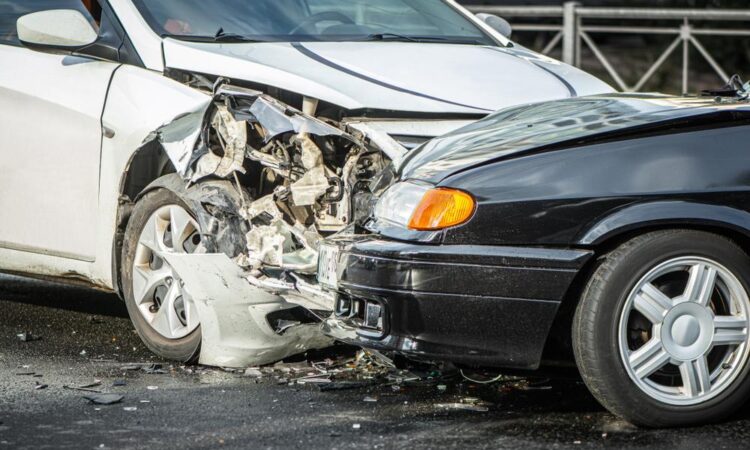As reported by the Insurance Information Institute, head-on collisions were responsible for 10% of fatal car accidents in 2020, leading to a staggering toll of 3,631 deaths and inflicting numerous injuries. These statistics highlight the gravity of such incidents on our roads. This page delves into the causes, injuries, and typical liability associated with these collisions, shedding light on this critical topic.
What exactly are head-on collisions?
Head-on collisions are direct frontal impacts between two opposing vehicles or with a stationary object, such as a telephone pole or a traffic barrier. These accidents between two moving cars are dangerous because of the immediate force between them that causes the hoods of the vehicles to crumple as they absorb the impact.
Causes of Common Head-On Collisions
Head-on collisions occur when a vehicle veers into the opposing lane and oncoming traffic crashes. The causes behind these collisions can vary, but several recurring factors contribute to this type of accident. Let’s explore the most prevalent reasons for head-on collisions.
- Distracted driving: Drivers texting, talking on the phone, or otherwise distracted may cross lanes and collide with stationary objects or other vehicles.
- Drunk driving: Drunk drivers tend to veer into oncoming traffic.
- Driving while tired: A driver who nods off or closes his eyes risks crashing.
- Uncertainty among drivers: When approaching a one-way street or freeway, drivers risk colliding head-on.
- Careless driving: Uncontrolled motorists risk colliding with opposing or stationary vehicles. For example, if you cross a double yellow line to pass, you risk colliding with oncoming traffic.
- Poor road design: Head-on collisions can also be caused by a lack of signage or unsatisfactory, dangerous roads.
Common head-on collision injuries
- Spinal cord damage
- Whiplash
- Traumatic brain injury
- Broken bones
- Blunt force trauma
- Organ damage
- Burns and scars
When two objects collide head-on, who is at fault?
Head-on collisions typically involve a single driver, although instances can arise when an impaired or fatigued driver crosses into the opposite lane, leading to such a collision. In some instances, confusion or poorly placed signs on roadways can be attributed to the negligence of roadway designers, making them liable for the accident. Generally, the driver responsible for causing the collision bears the responsibility for covering all related expenses. It’s important to note that in jurisdictions that follow the doctrine of comparative negligence, car accident victims retain the right to sue the driver at fault, even if they share some degree of fault. While in no-fault jurisdictions, drivers may be required to seek compensation from their own insurers for minor injuries. Victims still have the option to pursue legal action against the at-fault driver in cases of serious injuries, which are often encountered in head-on collisions.
What would happen if multiple drivers caused a head-on collision?
Head-on collisions commonly involve a single driver, although there are instances where both drivers bear responsibility for the collision. In jurisdictions with comparative fault laws, accident victims still have the ability to pursue legal action. These laws grant drivers the right to sue reckless drivers, even if they share some degree of blame. However, the compensation awarded is reduced proportionately based on the victim’s percentage of fault. For example, if a victim found to be 30% at fault received $100,000 in damages, they would be awarded $70,000. Pure comparative fault laws always allow victims to sue another driver, regardless of their level of fault.
On the other hand, in states that follow modified comparative fault, a victim of a head-on collision can pursue legal action if the other driver is at least 50% or 51% at fault, depending on the state. It’s worth noting that in some cases, accident victims are barred from suing if they are even slightly to blame for the incident. Consequently, in a head-on collision, a driver found to be 1% at fault would not be able to sue the other 99% involved. Fortunately, many states have adopted rules that do not adhere to this strict guideline.
Compensation for Direct Impact
Compensation for victims of head-on collisions can vary greatly, taking into account various factors such as the severity of injuries, property damage, and insurance coverage. The following are common components of compensation for victims of head-on collisions:
- Medical expenses: This encompasses the cost of hospitalization, surgeries, medications, physical therapy, and any other necessary medical treatments resulting from the accident.
- Lost income: If the victim is unable to work due to their injuries, they may be eligible for compensation to cover lost wages, benefits, and any potential income they would have earned if not for the injuries.
- Pain and suffering: Victims may receive compensation for the physical pain, emotional distress, and mental anguish caused by the accident.
- Property damage: If the victim’s vehicle was damaged in the collision, they may be entitled to compensation to cover the repair or replacement costs.
- Punitive damages: In certain circumstances, the court may award punitive damages to punish the at-fault party for their negligent actions.
In conclusion
When two cars collide head-on, the victims are frequently seriously injured. “The emotional distress of being denied the rightful compensation one deserves after such a traumatic experience can be retraumatizing to the victims and their loved ones,” says car accident lawyer Max Paderewski from Lone Star Injury Attorneys. It’s important to note that the specific amount of compensation will depend on the individual case, and seeking legal advice from a qualified professional is recommended to understand the full extent of potential compensation. To determine what compensation may be available, it’s recommended to consult with an experienced personal injury attorney.

